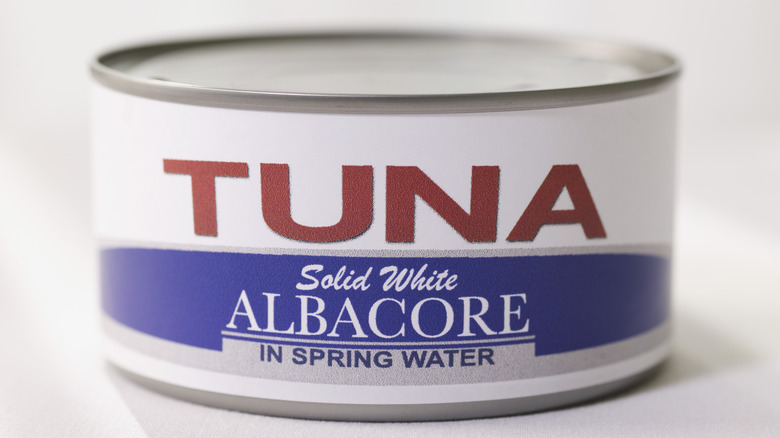If You Like Tuna But Not Its Smell, Give The Vegan Version A Try
There are many reasons why tuna is one of the most consumed fish in the world: It is rich in omega-3s and vitamin B12, full of protein, and versatile enough to be used in cuisines around the globe. But while a freshly seared tuna steak or tuna sushi roll would make many a mouth water, there is a portion of the population that cannot stand canned tuna.
Even if you love the taste, canned tuna, which has been an American staple since the 1920s, has a famously pungent smell. If someone is cracking open a can in the kitchen, you can be assured you'll smell it in the living room. And, if you leave an open can of tuna in the fridge, you could launch a cohabitation war. Even people who love fish and enjoy the taste of tuna sometimes struggle to combat the specific cat food smell of tinned tuna.
There are a few companies aiming to target both lovers and haters of canned tuna through plant-based tuna products that will make you rethink your tinned fish skepticism. But what are these new participants in the fake fish game, and are their products up to snuff?
What plant-based tuna is made of
As with any faux meat, there are a wide variety of ingredients that can be used to make imitation tuna, from tomatoes to navy beans. You may have even encountered the viral grilled watermelon "tuna" hack.
There are dozens of toonas, vunas, and tunos on the market that all use different types of plant-based food products to approximate tuna's texture and protein content. However, commercial plant-based tuna producers seem to be leaning heavily on legume and wheat protein.
Nestlé's Garden Gourmet makes a "Sensational Vuna" product that uses pea and wheat protein. Loma Linda and Lily's Vegan Pantry both make gluten-free vegan tuna from soy protein. Jinka, which makes tuna spreads in different flavors (Original, Spicy, and Lemon & Dill), uses soy and wheat flour as well as omega-3-rich algal oil. And Good Catch, which packages its different flavored "tunas" in pouches, uses a mixture of proteins, including soy, peas, chickpea, faba, and navy beans.
Some plant-based tuna brands, like Loma Linda, use seaweed to give their faux tuna the fishy smell of real tuna. Others, like Good Catch, add no additional ingredients meant to trick the nose, resulting in a product that doesn't smell like much of anything.
What you can make with plant-based tuna
Plant-based tuna can be used largely in the same way as normal tuna. It can be formed into patties and fried for a crispy tuna fritter, perhaps with a dill-cucumber dip. (Chickpea flour works well as a binder if you're not using eggs.) It can be dressed with spicy mayo and used as a topping for a rice bowl or a filling for tuna onigiri. And it makes an easy toast topping, perhaps with a sprinkle of capers, some freshly cracked black pepper, and a drizzle of lemon juice.
Of course, vegan tuna can also be used for a classic tuna salad or a tuna salad sandwich. In fact, The Takeout set out to test whether or not plant-based tuna lived up to the hype by trying out Good Catch's faux tuna on a self-described tuna hater, writer Angela L Pagán, to see what she had to say about it. Pagán was surprised by the scent, a subtle odor of canned chickpeas, which was far less obtrusive than the smell of real tuna. The verdict was that the vegan tuna worked well in tuna salad, but didn't need to be seasoned as heavily as real tuna as there was no need to measure up to tuna's strong fishy scent.


